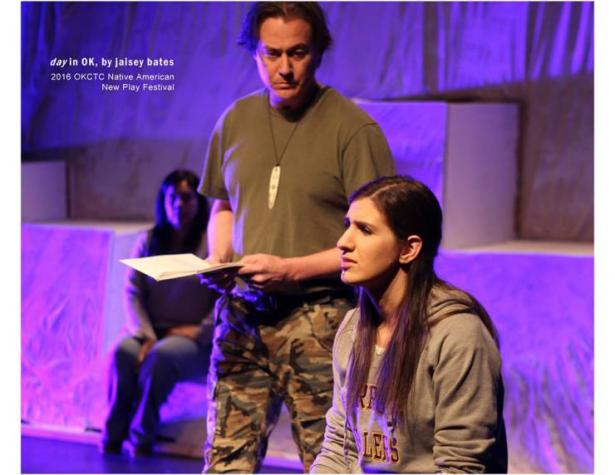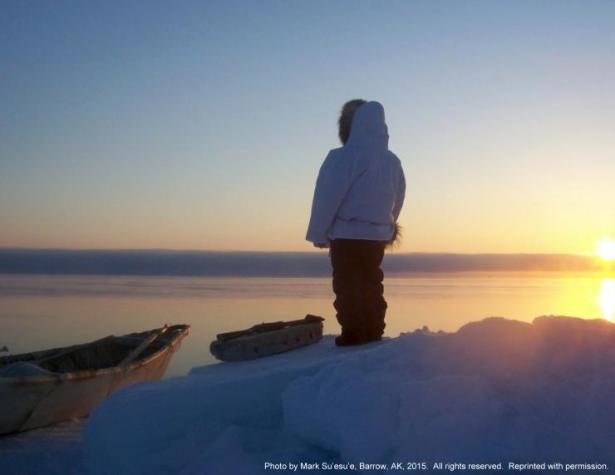This post comes from the Artists and Climate Change Blog
This article was originally published on HowlRound, a knowledge commons by and for the theatre community, in April 2016.
by Jaisey Bates
A simple equation for survival:
- In this Anthropocene Age of human-wrought catastrophic climate change, Indigenous people including US Native communities are center stage in dual roles: as those disproportionately affected by the escalating environmental devastation, and as those uniquely voiced with perspectives of vital importance.
- If we wish to sustain this world for our children and future generations, we must with open minds gather and share information and expertise. We must commit to positive change and work together toward possible cures. Therefore, ergo, ipso facto, in sum:
- We need Native voices center stage. We need a good Ceremony:

We need, collectively, to break up with Aristotle and elementally reframe and fast-track evolve a holistic understanding—an Indigenous understanding—of what it means to be human in a vibrant world that includes and transcends humankind.
We need Native voices—historically dehumanized, marginalized, silenced, and subject to appropriation—center stage in all discussions leading to effective efforts, as Native communities are center stage in the experience of climate change.
As artists and theatremakers, we can do this. We have a unique opportunity and imperative to bring Native voices center stage in the literal sense in order to raise awareness and foster inclusion, action, and change. Because theatre can unfold worlds and words which contribute to the way we choose to walk, in the precious few moments we are gifted, this beloved ground. Because theatre, at its heart, is a Ceremony.
An aside—actually, a request? Go outside, look at the night sky. Or picture it, if the predominant patriarchal sans pigmentation perspective and/or pollution-choked atmosphere currently screens the stars from your particular vantage point.
Take a moment. Breathe. Can you see a sky radiant with the songs and souls of gone stars? Starlight, the language of past stars’ lives, and infinite new stars as yet invisible from Earth exist across and outside of time whether or not we are here.
But manifolds and quarks and quantum fields and parallel/string theory/coincident dimensions and permutations and entanglement and math, lots and lots of math, and endlessly mutable extrapolations might supersaturate and/or give rise to existential angst and/or nihilism, which won’t help us in our current struggle against time to save our home and ourselves.
So for this one moment, for the–space–of–this–one–long–breath, simply watch the stars. Inhale. Exhale. Wonder at the existence, the essence, of the nonhuman entities before you. Open yourself to the vibrant infinite diversity of the nonhuman lives and languages around you. Be still. Listen. Everything speaks.
Now pick a star, any star, reverse the perspective and watch this planet recede until it’s almost impossible to distinguish. A ginormous ’50s era blazing lightbulb-bordered motel sign arrow appears, pointing to that distant tiny fragile blue place that is your home: YOU ARE HERE. The sign flashes once, twice, again. It and Earth and we are gone.
This is the end of the story we as humans are writing on this world.
But we can change this narrative.
the day we were born, one of my full-length plays in development, is set in the Iñupiaq Native Alaskan community of Barrow (Ukpiaġvik), the northernmost US city, within a culture and climate in crisis. This play about whales and words and wars and what it means to be human and how we can heal ourselves and this world that is our home has its origins on a windy LA October day in 2011, during a writers’ workshop hosted by Native Voices at the Autry, when Dr. Bernardo Solano gave us a homework assignment. After we read our work aloud, Native Voices Co-Founder/Producing Executive Director Jean Bruce Scott strongly encouraged me to expand the scene I’d written into a full-length play.
—“But I’m not Native Alaskan,†I said.
—“You’re Native American,†she said.
—“But Qi swears a blue streak and it’d be a big cast and—â€
—“Please, write this story,†she said.
So I did, immensely grateful as an unknown writer of nontraditional stories that at least one person would read the play. But Jean did far more than just read the first draft—she included day in Native Voices’ Fall 2012 First Look Series—and, encouraged by the audience’s response, I’ve continued to develop the play through research and engagement of this vibrant and challenged Indigenous community and environment in the hope of rendering a healing ceremony of a story worthy of audiences and the trees. All the trees.
The lessons have been immense. The quest to learn more is ongoing and each new experience, awareness, connection, correlation changes the text not just of this story but of me and my life. How I experience what it means to be human. How I navigate this journey.
Because I am a story made of words.
And we are a story together.
We can change our story. We, as artists, as theatremakers in this age of climate change, can do this. We can bring Native voices center stage.
A simple equation for Indigenous inclusion:
- Read Mary Kathryn Nagle’s HowlRound blog and #InsteadofRedface series.
- Develop and produce plays by Native playwrights. See MKN’s new play, Fairly Traceable. See Diane Glancy, Joy Harjo, Linda Hogan, Dark Winter Productions, #InsteadofRedface. I and my words also humbly volunteer as climate change theatre action Tribute.
- Hire Native actors and directors. Reread the #InsteadofRedface series, especially Kimberly Norris Guerrero’s article.
- Seek Native partnerships, collaborations, consultancies. See Chantal Bilodeau’s Silaand Sharmon Hilfinger’s Arctic Requiem.
- Consider Indigenous voices. See #StandingRock, #NoDAPL, #WaterIsLife, #‎MniWiconi, #HonorTheTreaties, #‎RezpectOurWater.
- Repeat steps 1-5.
For we are made of our words, you and I.
We stand this ground together. We are a story together.
Let us write together a strong and beautiful world worthy of our children’s children.
Let us heal our home and ourselves. Let us make a good Ceremony.
All depends on this.
Photo one:
“I have lived in Kaktovik all my life, rich in culture and traditions. I love working with children and care deeply about language and culture of the Iñupiat of the North Slope.â€
— Flora M. Rexford, Iñupiaq Language Teacher in Kaktovik, Alaska
Climate change is evident:
The Arctic’s receding ice is causing polar bears (nanuq) to seek food on the mainland, increasing encounters between polar bears and humans, like Ms. Rexford’s mother’s and grandmother’s experience.
Connection to the environment is elemental:
“In the new Iñupiaq to English dictionary by Edna Maclean, there are 92 terms for ice, 16 of which are based on the term siku, 76 terms listed for snow and frost.â€
— Qaiyaan Harcharek, Taġium Iñuŋi forum posting, 8/15/16
Photo two:
“This world is changing, Qi. This world is fragile. We need to find new stories to help protect this world, our home, before it’s too late. This world needs us, Qi.â€
— Benny
“I think about Benny every day. Benny cares so much about the world, his ever changing world. He wants to help heal the world and I admire his strength in trying to help the one world while standing in two. That takes guts. That takes balance.â€
— Mosiah Salazar Bluecloud
L to R: Mosiah Salazar Bluecloud (Benny) and Dillon Griffitts (Qilalugak/Qi). Workshop staging of day directed by Ronald Deron Twohatchet during the 2016 OKCTC Native American New Play Festival. Photo: Mark Williams/Digital Feather Media. © Jaisey Bates/The Peoplehood.
Photo three:
“We need you to remember our songs, our stories / to heal this broken world, our home. We need you to dream new songs, new stories / to heal this broken world, our home. All depends on this.†— White Caribou Belly Woman
L to R: Maya Torralba (Mother), Russ Tallchief (Soldier) and Tiffany Tuggle Rogers (White Caribou Belly Woman). Workshop staging of day directed by Ronald Deron Twohatchet during the 2016 OKCTC Native American New Play Festival. Photo: Mark Williams/Digital Feather Media. © Jaisey Bates/The Peoplehood.
Photo four:
An Iñupiaq subsistence hunter studies the Chukchi Sea.
Photo by Mark Su’esu’e, Barrow, AK, 2015. All rights reserved. Reprinted with permission.
______________________________
Jaisey Bates writes, directs and performs her nontraditional work with her multicultural nomadic theater company, The Peoplehood. LA and NYC venues for her words’ development and performance have included the Agüeybaná Book Store, Art/Works, Eclectic, Lounge, Naked Angels, Native Voices at the Autry, Open Fist, Performance Loft, Samuel French Bookshop, Studio/Stage, Unknown and Victory theaters. Her words have enjoyed road trips to theaters in Arizona, Iowa, New Mexico, Oklahoma and Texas.
About Artists and Climate Change:
Artists and Climate Change is a blog that tracks artistic responses from all disciplines to the problem of climate change. It is both a study about what is being done, and a resource for anyone interested in the subject. Art has the power to reframe the conversation about our environmental crisis so it is inclusive, constructive, and conducive to action. Art can, and should, shape our values and behavior so we are better equipped to face the formidable challenge in front of us.






